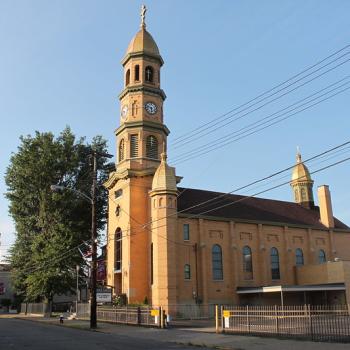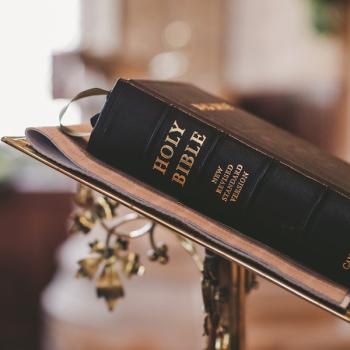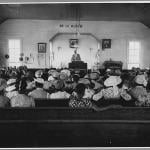Thus, these “impious and ill-omened men […] men emerging out of darkness (for they are spawn of the Western part of the world) […] coming to this pious and God-guarded city […] just like a thunderbolt or an earthquake or an abundance of hail, or, if it is necessary to speak rather more fittingly, as a solitary, savage boar, laid hands to defile right reason with a difference of dogmas” (Caer. Edict). Having arrived in the city, the legates, after meeting with the Emperor, immediately came before Cerularius to present their letters to him. However, Cerularius was immediately offended by their arrogant manner: “what would someone say to so much showiness and imposture and audacity as they employed?” (Caer. Petr. VI). The legates absolutely refused to pay homage to Cerularius, as was customary for ecclesiastical inferiors, and Cerularius found their manner of address disrespectful. Likewise, when they were supposed to celebrate the Liturgy together, the legates refused to process into Church behind the Metropolitan Bishops, but insisted on being at the head of the procession, with the Cross and the Imperial Scepter. “What,” Cerularius later exclaimed,” is more senseless than these things?” (VI).
Having delivered their letters, the legates then departed from Cerularius. However, when Cerularius took up their letters to examine them, he apparently found the seals broken—an indication that they had been read and tampered with—and the letters “full of deceit and fraud” (VII). Combining this information with that purportedly given to him earlier by the Archbishop of Trani, Michael detected what he believed to be Arguros’ hand at work.
However, the supposed legates continued to make trouble, finally casting a document of excommunication onto the altar of the Hagia Sophia–a document “through which by an anathema they assaulted us, or rather the Orthodox Church of God” (Caer. Edict)–and immediately leaving the city. Cerularius, however, “not consenting that so great an outrage and unworthiness against piety remain unexamined and unpunished” (Caer. Edict), immediately went to the Emperor and asked that they be brought back to the city. When the legates returned, Cerularius demanded that they come before the Synod of Constantinople to explain themselves, but the legates absolutely refused, “wish[ing] to die rather than to come into our presence and to the Synod” (Caer. Edict). Cerularius wished the legates to be seized by force and brought before the Synod anyway, but the Emperor refused to allow it; however, “since, again, it was unfitting and otherwise unworthy that so great shamelessness against piety should remain unpunished” (Caer. Edict), Cerularius finally managed to persuade the Emperor to take action. Emperor Constantine IX sent a letter to Cerularius blaming the Latin interpreters “of the party of Arguros” (Caer. Edict), for the whole incident, accusing them of having suborned the legates themselves into doing what they did. Thus, after having them beaten soundly, the Emperor handed over these Latin interpreters to Cerularius to do with as he wished, and threw an Imperial official connected by marriage to Arguros, as well as his son, into prison, “so that in prison they might pass their lives atoning for their evil, just as they deserve because of so great a charge” (Ibid). Finally, the Emperor ordered Cerularius to publicly burn Humbert’s document of excommunication, and then to excommunicate “the ones having conspired to create the document, and the ones having given it out, and the ones having written it, and the ones holding even the smallest knowledge of their doing” (Ibid). Cerularius was only too happy to comply.
Besides the charges of conspiracy and disrespect, Cerularius’ decree of excommunication also lists a number of theological charges against the legates and the Western Church in general, in response to Humbert’s own accusations. One of these, which Cerularius highlights several times, is the Western Church’s custom of having clergymen shave their beards closely, a custom Cerularius considers “against nature” (Caer. Edict), “fitting for women, but […] unfitting for men” (Ibid.), and contrary to God’s judgment and the Scriptures. Likewise, Cerularius takes strong issue with the Western practice of clerical celibacy, as well as the practice of refusing to receive communion from married priests (a tactic used to enforce celibacy on the recalcitrant); he considers both of these things contrary to canon law and tradition. Cerularius does, however, also respond to Humbert’s accusation on the filioque in the strongest of terms, refusing absolutely “to adulterate the sacred and holy Creed […] with counterfeit sayings and interpolated words” (Caer. Edict), “because neither from the evangelists do they take this word, nor from an ecumenical synod have they acquired this dogma of blasphemies” (Ibid). Cerularius, however, goes beyond attacking the addition of these words to the creed to attacking the doctrine of the procession of the Spirit from both the Father and Son itself. In this, he repeats some technical arguments earlier made by Photius in the 9th century, arguing that this doctrine violates the unity of the Trinity and makes the Holy Spirit less divine than the Father and the Son. Justified by these arguments, Cerularius then proceeds to excommunicate the legates and their accomplices in Constantinople—but not, of course, either the Pope himself, or the Western Church in general.












